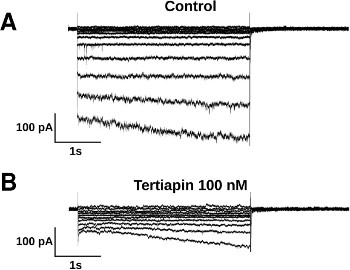Overview
- Jin, W. and Lu, Z. (1998) Biochemistry 37, 13291.
- Drici, M.D. et al. (2000) Br. J. Pharmacol. 131, 569.
- Kitamura, H. et al. (2000) J. Pharmacol. Exp. Ther. 293, 196.
- Jin, W. et al. (1999) Biochemistry 38, 14294.
 Alomone Labs Tertiapin-Q inhibits Kir3.2 channel heterologously expressed in Xenopus oocytes.A continuous current trace recorded at a holding potential of -80 mV. Kir3.2 currents are downward reflections activated by high K+ containing solution. While activated, increasing concentrations of Tertiapin-Q (#STT-170) were applied (arrows at the bottom of the trace).
Alomone Labs Tertiapin-Q inhibits Kir3.2 channel heterologously expressed in Xenopus oocytes.A continuous current trace recorded at a holding potential of -80 mV. Kir3.2 currents are downward reflections activated by high K+ containing solution. While activated, increasing concentrations of Tertiapin-Q (#STT-170) were applied (arrows at the bottom of the trace).
Tertiapin, the native toxin, was originally isolated from European honey bee Apis mellifera venom. Native and synthetic Tertiapin blocks a range of inward rectifier K+ channels (Kir), in particular ROMK1 (Kir1.1, IC50 = 2 nM) and GIRK (Kir3 family, IC50 for the Kir3.1/3.4 heteromer was 8.6 nM) but with no effect on the Kir2 family member1. In accordance, it was shown to inhibit acetylcholine induced K+ currents in mammalian cardiomyocytes2,3.
Tertiapin-Q is a derivative of Tertiapin in which Met13 is substituted by a Gln residue. However, unlike native Tertiapin, Tertiapin-Q is non-oxidizable and therefore is more stable4.
Tertiapin-Q inhibits the above-mentioned channels with similar affinities and also inhibits Ca2-activated large conductance BK-type K+ channels in a concentration and voltage-dependent manner5.

Alomone Labs Tertiapin-Q blocks time-dependent hyperpolarization-activated current (IKH) in rat atrial cardiomyocytes.Whole-cell voltage-clamp was performed on neonatal rat atrial cardiomyocyte (NRAM) primary cultures. A. The voltage-clamp recordings depict large inward currents evoked by hyperpolarizations (5 sec), whereas, very little current is activated during steps to -50 mV and more positive potentials. Na+ current (INa) and T-type Ca2+ current (ICaT) are inactivated by holding the cells at the potential of -40 mV. B. In the presence of Tertiapin-Q (#STT-170) (100 nM), which selectively suppresses the constitutively active acetylcholine (ACh)-mediated K+ current IKACh-c component of IKH, only inward rectifier current (IK1) is left with K+ leak.Adapted from Majumder, R. et al. (2016) PLoS Comput. Biol. 12, e1004946. with permission of PLoS.

